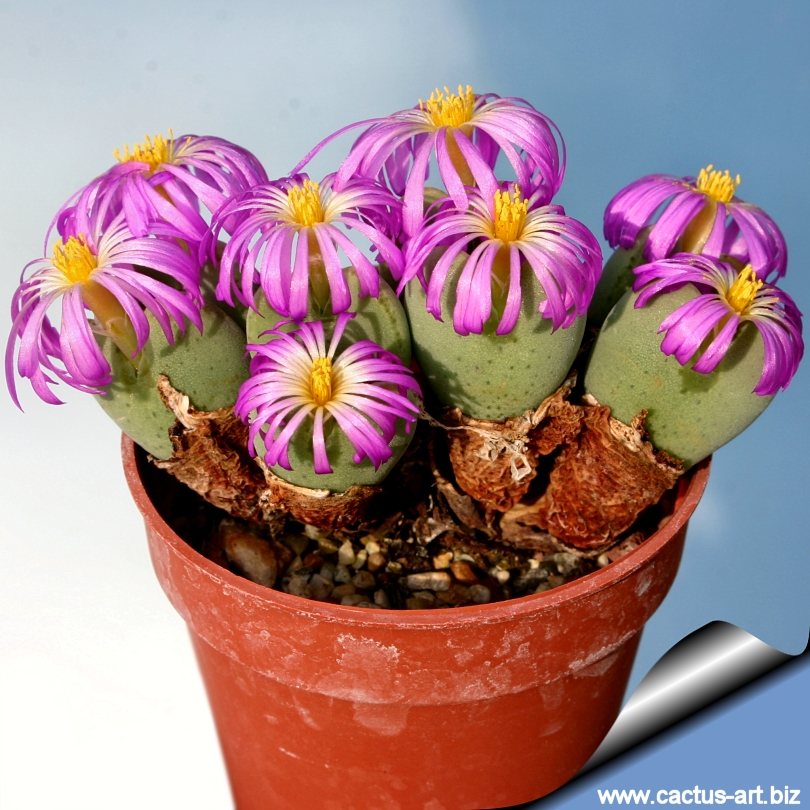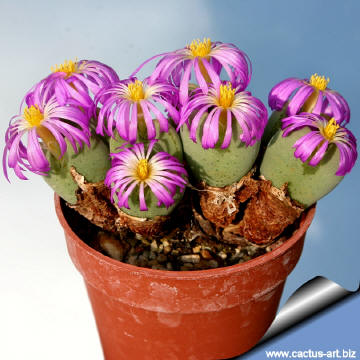|
|
|

The name Latin name "cordatum" means "Heart shaped" for the shape of the
plants bodies, it is a richly branched groundcover plant and one of the
easiest of all to grow.
|
|
Description: Richly
branched groundcover species. This plant would
appear to be very similar in form and size to C. velutinum.
Stem:
Branched with very short
internodes, but sometime - especially plants grown well protected from
strong sun light – can have relatively long internodes and form small
shrubs 5-7 cm tall.
Bodies: 20-25 mm high, 12-15 mm broad, and 8-10 mm thick cordate
(heart-shaped) in outline and keeled. Bluish
green to hoary in appearance. The epidermis could be
spotted or completey smooth.
Flower: Scentless, large
(up to 3 cm), petals spreading, white to light violet at the base
and violet or magenta toward the tips.
Blooming season: The flowers are autumnal (rarely in summer) and
diurnal.
NOTE: This plant is one of the innumerable form of
Conophytum bilobum which is one of the most widespread and
morphologically variable taxon.
|
 |
 |
|
. |
 |
 |
|
Advertising
|
|
|
|
|
Family: Mesebrianthemaceae (Aizoaceae)
Conophytum cordatum Schick &
Tischer 1927
Accepted
Scientific name: Conophytum bilobum,
(Marloth) Nicholas Edward Brown 1922
BILOBA GROUP
Origin: It is found in the western part of South
Africa
Habitat: Growing in a well drained
soil with some water in winter and some sun.
Synonyms:
- Mesembryanthemum bilobum Marloth
1907
- Conophytum cordatum Schick &
Tischer 1927.
- Conophytum auctum forma forma auctum
N.E.Br.
- Conophytum gregale N.E.Br.
- Conophytum curtum L.Bolus
- Conophytum incurvum var. incurvum
N.E.Br.
- Conophytum absimile L.Bolus
var. major L.Bolus

|
|
|
|
Cultivation: All the forms
of C. bilobum are easy to grow. These plants grow on
winter rain and head for summer dormancy. They require little water;
otherwise its epidermis breaks (resulting in unsightly scars). Water
minimally in summer, (only when the plant starts shrivelling), but it
will generally grow even in summer if given water. Water regularly in
winter after the previous year's leaves have dried up. Requires good
drainage. Keep cool and shaded in summer, it needs full sun or light
shade. Hardy to -2°C. Ensure a very good ventilation. Avoid to repot
frequently. This plant may stay in the same pot for many years.
Propagation: It can be
reproduced both by cuttings and seeds. Take the cutting from a grown-up
mother plant. Each
cutting must contain one or more heads along with
a fraction of root.
CONOPHYTUMS: Plants of the genus
Conophytum are also known as 'living pebbles'. During
the rest period (the summer months in Europe) a new body forms inside
the old, gradually taking all the substances from it until all that
remains is the skin, which dries and protects the young plant from the
heat of the sun and excess evaporation of water. The resting Conophytum
protected by this dry cover resembles a pebble and hence the name
'living pebble'. The growth period of most species is from August to
March. The temperature should be about 10 to 12°C
Photo of conspecific
taxa, varieties, forms and cultivars of to
the Conophytum bilobum
complex (This
Taxon has lots of synonyms ( like
many other Conophytum) whit several controversial varieties and
subspecies and comprises a multitude of different forms, but where each
form is linked to others by populations of plants with intermediate
characteristics):


|
|